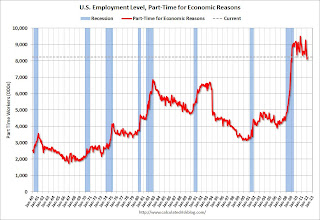by Calculated Risk on 2/03/2012 10:54:00 AM
Friday, February 03, 2012
Employment Summary, Part Time Workers, and Unemployed over 26 Weeks
This was a solid report and well above expectations. However there is still a long ways to go for a healthy labor market with solid wage gains.
There were 243,000 payroll jobs added in January, with 257,000 private sector jobs added, and 14,000 government jobs lost. The unemployment rate fell to 8.3% from 8.5% in December. U-6, an alternate measure of labor underutilization that includes part time workers and marginally attached workers, declined to 15.1%. This remains very high - U-6 was in the 8% range in 2007.
The annual benchmark revision indicated 165,000 more payroll jobs in March 2011; the first positive benchmark revision since 2006. The BLS also adjusted the population control by the Census 2010 data. This resulted in a large increase in the labor force and an even larger increase in the "not in the labor force" category.
However - in the not good news category - the participation rate declined to 63.7% and the employment population ratio was unchanged in January at 58.5%.
The average workweek was unchanged at 34.4 hours, and average hourly earnings increased 0.2%. "The average workweek for all employees on private nonfarm payrolls was unchanged in January. ... In January, average hourly earnings for all employees on private nonfarm payrolls rose by 4 cents, or 0.2 percent, to $23.29. Over the past 12 months, average hourly earnings have increased by 1.9 percent." This is sluggish earnings growth, and earnings are still being impacted by the large number of unemployed and marginally employed workers.
There are a total of 12.8 million Americans unemployed and 5.5 million have been unemployed for more than 6 months. Still very grim.
Overall this was a solid report, but still not enough given the slack in the economy.
Percent Job Losses During Recessions
 Click on graph for larger image.
Click on graph for larger image.
This graph shows the job losses from the start of the employment recession, in percentage terms - this time aligned at maximum job losses.
In the previous post, the graph showed the job losses aligned at the start of the employment recession.
Part Time for Economic Reasons
 From the BLS report:
From the BLS report:
The number of persons employed part time for economic reasons, at 8.2 million, changed little in January. These individuals were working part time because their hours had been cut back or because they were unable to find a full-time job.The number of part time workers increased slightly in January and is still very high.
These workers are included in the alternate measure of labor underutilization (U-6) that declined to 15.1% in January from 15.2% in December.
Unemployed over 26 Weeks
 This graph shows the number of workers unemployed for 27 weeks or more.
This graph shows the number of workers unemployed for 27 weeks or more. According to the BLS, there are 5.518 million workers who have been unemployed for more than 26 weeks and still want a job. This was down from 5.588 million in November. This is very high, but this is the lowest number since September 2009. Long term unemployment remains a serious problem.
More graphs coming ...


